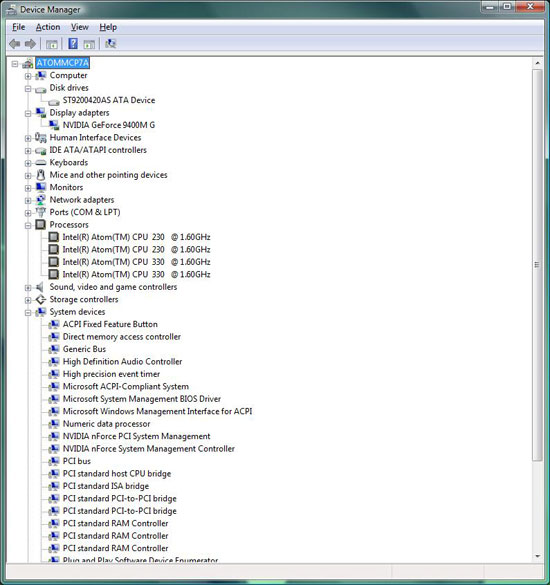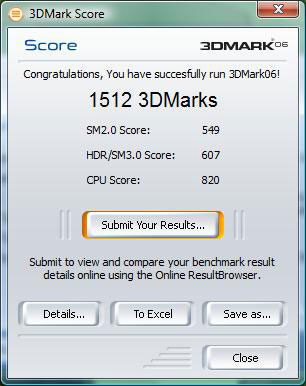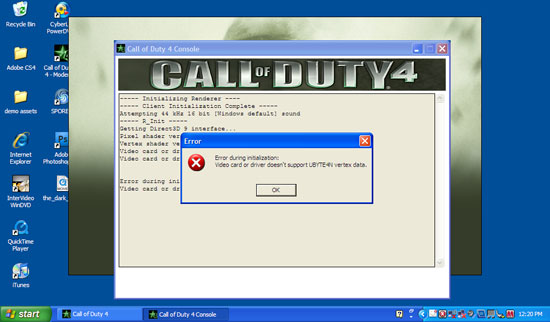NVIDIA's Ion Platform: Hands on at CES 2009
by Anand Lal Shimpi on January 13, 2009 12:00 AM EST- Posted in
- GPUs
Remember NVIDIA’s Ion platform, the neat little box we previewed last month? Ion combines Intel’s Atom processor with NVIDIA’s GeForce 9400M instead of the existing Intel chipsets.
NVIDIA invited me to benchmark Ion at CES. A cab ride down to the MGM in Vegas and soon I was escorted up to NVIDIA’s Ion room. Not big on partying, the Ion platform kept a neat, clean and alcohol-free room (the same can’t be said for its bigger GeForce brothers). Sitting on the table were two machines: an Acer Aspire netbook and an Ion reference platform similar to the one I looked at last month.

NVIDIA allowed me to benchmark the two systems in a handful of tests, unfortunately the deck was stacked in NVIDIA’s favor. The Ion reference platform had a dual core Atom 330, while the Acer Aspire had a single-core Atom N270. They ran at the same clock speed, NVIDIA’s platform just had twice the cores.

1.60GHz, 2 cores, 4 threads (2 per core) - it's the dual-core Atom 330. Unfortunately the Acer netbook only had a single core
Things got more unfair on the memory side. NVIDIA’s platform had 2GB of DDR3, while the Acer Aspire had 1GB of DDR2. The difference in memory technology was unavoidable, 945G doesn’t support DDR3, but the difference in memory size could’ve been avoided.

One core (2 threads) and a 5400RPM drive in the Acer netbook
Then there were differences in drives. The Acer netbook used a 5400RPM Western Digital drive, while the NVIDIA Ion reference platform had a 7200RPM Seagate drive in it. Simple things like launching Spore took less than half the time on the Ion system because of this difference.

The Ion platform had a more aggressive configuration
While I believe that the NVIDIA PR present wasn’t involved in the unacceptably different setups, someone was, and it made it so I couldn’t compare the two platforms. I could provide you with performance results here, or even usage impressions, but it wouldn’t be fair. I’ll wait until I have hardware in house before making a scientific comparison between the Intel and NVIDIA versions of the Atom platform.

3DMark 06 at 800x600, default settings, on the Ion platform with an Atom 330 and 2GB of DDR3
Obviously NVIDIA’s Ion will play games a bit better, or at least at higher quality settings. For example, you could run Spore on both the Atom + 945G setup and NVIDIA’s Ion at 800 x 600. The frame rates were comparable, but you had to run at Low quality for the 945G setup while you could run Medium on Ion.
Fundamentally I’m not sure I’d really see much of a benefit to Ion in a netbook. The biggest advantage is going to be full hardware H.264/VC-1/MPEG-2 decode acceleration, which you can also get from Poulsbo. The improvement in gaming performance will be there, but I’m not convinced that you’d want to game on a netbook in the first place. They are cramped and the integrated trackpads usually suck; you could always carry around an extra mouse, but that’d defeat some of the portability of a tiny netbook.

Call of Duty 4 won't run on the 945G equipped Acer netbook. NVIDIA's Ion fixes this, I'm just not sure you'd want to play CoD4 on it in the first place.
Now in a Mac mini-esque device, home file server, mini HTPC or larger netbook/notebook the Ion platform starts to make more sense. In the end I prefer having more options than fewer, so bring on Ion based designs and let’s see if/where they make sense.










29 Comments
View All Comments
Roland00 - Tuesday, January 13, 2009 - link
The asus you are referring to is using the discrete version of the chip. It isn't built into the motherboard like the ion. Doing so saves cost, space, and to some extent heat and battery life.mmntech - Monday, January 12, 2009 - link
You're thinking of antitrust/competition law. Fair Use deals with copyright.All I can say is the 9400M is a pretty decent GPU for the low power market. It scores about 2000 3DMarks on the MacBook, which is vary respectable for an IGP. Intel's GMAs are pretty much useless these days, especially the 950. This might force them to innovate their platform.
yyrkoon - Tuesday, January 13, 2009 - link
Yes, thanks antitrust/competition laws are what I was thinking, just could not think of the correct term.Low powered decent graphics are exactly what I am personally looking for. Something to play most older titles decently, and not draw 5 Mw just to use the darned things. I have an Intel core 2 duo system with a NV 9600GT in it, and while playing WiC it does a great job, but at the cost of like 230W. Since we're solar now, this will not work of course, and I do not expect to play WiC on an atom system, but at least some older, or less demanding games.
has407 - Monday, January 12, 2009 - link
Yet the Z5xx (except Z500/Z510) supports VT but Diamondville doesn't? Why would anyone want VT on a MID vs. a netbook/desktop? Would be interesting to hear Intel's rational for the feature mix--silicon/power constrained, or marketing, or simply because they could with little or no penalty? Or does Intel expect VT in the MID market to be important? Or maybe not a MID but maybe a 24x7 very low power home gateway/management/virtual-appliance server? (Been on my wish list for a long time, and why VT support or its equivalent is of interest.)Fanfoot - Monday, January 12, 2009 - link
While the Z and N series Atom's may be comparable, as you say the buses are different, so they require different support chips. As far as I know this means that with a Z-series Atom, you are stuck with the Poulsbo chipset. Which means that with the Z-series Atom's you implicitly take on the limitations of Poulsbo.Could you clarify what the limitations of Poulsbo might be? Like for example is it still limited to 1GB of RAM? What about the advantages, like the supposed video acceleration and power savings. Have you done any testing that suggests these claims are in fact valid?
For example, Dell has chosen to use the Z530 in their upcoming Mini 10 model, and I wonder what the advantages/disadvantages might be wrt the Dell Mini 9? Will that 3 cell battery last longer? Will it handle 1080i video playback better (at all) than the Mini 9? Will there be a RAM slot on the back like with the Mini 9? Does a manufacturer have to use Poulsbo to offer HDMI support? What about SATA drives?
has407 - Tuesday, January 13, 2009 - link
FWIW... Based on the Intel datasheet, Poulsbo is limited to 1GB (1.8V X 2 or 1.5V X 1, 512Mb or 1025Mb devices), but whether those are silicon or marketing limits is unknown. The part TDP is 2.3W, and Intel shows a system TDP (w/Z500) of 2.95W, which bodes well but obviously assumes the lowest power Z500. Even with that, we might see a solution come in at 20-25W. Whether that provides adequate video performance is more difficult to interpret... both H.264 and VC1 appear to be supported at 1080i/30fps. However, what that means in the real world will likely have to wait until we see hands-on testing. (Of note, the datasheet specifically does *not* mention support for VC1/L4, so those looking for 1080p/30 for all HD may need to look elsewhere... unless the CPU can help make up the difference.) Obviously, some real-world/hands-on testing will be required before a verdict is in.Mr Perfect - Tuesday, January 13, 2009 - link
Poulsbro is no longer limited to 1GB, it is now capable of 2GB.They changed the spec and announced it in an update sheet.
You can check it out by going to Intel's site, finding the "Intel® System Controller Hub US15W" page, and then going to the "Technical Documents" section. The "Intel® System Controller Hub (Intel® SCH) Specification Update" PDF details the change.
http://download.intel.com/design/chipsets/embedded...">http://download.intel.com/design/chipsets/embedded...
has407 - Wednesday, January 14, 2009 - link
Thanks for the update (reminder to self: check before posting :)Khato - Tuesday, January 13, 2009 - link
Well, the real question on the 1GB limitation is whether it's silicon or packaging. The motivation for it was most likely packaging/target market segment, but due to the targeted design of the chip I wouldn't be surprised if that resulted in cutting any extra address logic from the design. Is 1GB really an issue? No way, so long as you're running a reasonable OS on it.As for the media performance of Poulsbo - http://www.anandtech.com/tradeshows/showdoc.aspx?i...">http://www.anandtech.com/tradeshows/showdoc.aspx?i...